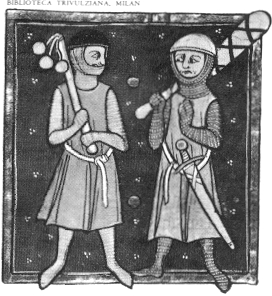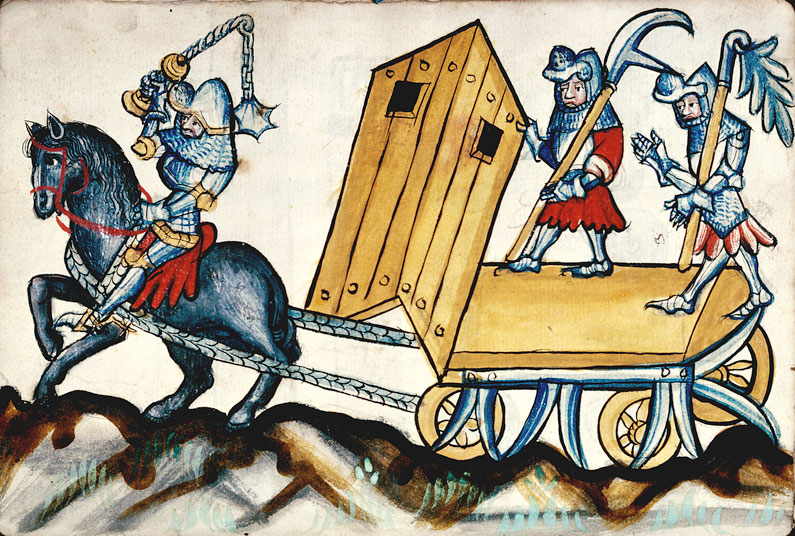| Author |
Message |
Michael Curl

Location: Northern California, US Joined: 06 Jan 2008
Posts: 487
|
 Posted: Tue 07 Feb, 2012 8:11 am Post subject: Posted: Tue 07 Feb, 2012 8:11 am Post subject: |
 |
|
I translated the polish text using google translate: For what its worth.
"One of the most interesting elements of the armor of the early (and medieval) seems undeniably so. Flail, with us called kiścieniem or basałykiem. Especially popular in Rus', has already been adapted in the eleventh century in Western Europe, where he reached the zenith of its glory during the fifteenth-century Hussite Wars and peasant uprisings.
Kiścień is a blunt weapon, consisting of a weight (ram) attached to a handle (dzierżaka) gążwą flexible [1] or a string. During the early-head: bone, horn or metal was attached to the thong, hands wrapped around the warrior, or purpose-made wooden handle. Fight kiścieniem was to implement it in a fast rotation and striking, resulting in could lead to injury, stun or kill the enemy. Kiścień used mainly in direct combat. It is associated primarily with the cavalry. In particular, copies made of bronze, often with great care, richly decorated, often covered with inscriptions, were owned by wealthy - horse - warriors.
Medieval written sources, however, clearly confirmed that they also handling the troops on foot. It is also known that they were well supplied with ordinary robbers.
On this item Rus arms was used from the tenth to the sixteenth century, inclusive. Kiścieni finds in Eastern Europe was once associated with the Mongols, now recognized as a weapon commonly used and is also produced in Rus. Considered to be part taken over by the Rus from the south-wschodnieuropejskich above the Black Sea steppes nomads. They appear already there in the late eighth century, and certainly exist in the centuries IX and X.
The earliest appeared in Rus clusters made of animal antlers of deer (elk, deer), or bone. These clusters of various shapes. There are copies of the oval, pear-shaped, spherical, cucurbits and dwustożkowate. Kiścieni of this type used in Rus from two mid-October - the thirteenth century inclusive. Originally, these clusters were provided with an iron rod, mounted in a hole passing through the center of the object to pin fastened strap. Somewhere in the early eleventh century, the Rus also appear in clusters made of iron and bronze, generally pear shaped or oval.
Brown clusters were often richly decorated with ornaments engraved with representations of geometric motifs or vegetable (there are also images of animals such as birds or lion). Clusters of this type were made by casting in molds, which gave them the ability to put on another kind of decoration, which had its importance in the struggle, namely the different sizes of tumors and nodules, sometimes giving them the appearance of pomegranate. Copies of belonging to these types are usually empty in the middle, so to give them a proper fighting weight, was placed inside the lead. Basałyki bronze and iron were used in Rus until the sixteenth century, but their greatest spread falls on the twelfth and thirteenth centuries.
In the territory of Rus found so far over 130 kicieni, of which a considerable portion in the vicinity of Kiev, and it seems that that is where some of them could be produced. In the area of present-day Polish are known so far very few finds kiścieni. In particular, they are grouped along our eastern border, on the land in the Middle Ages to the Kievan Rus' (Galicia-Vladimir). Kiścieni copies are known especially from the Lublin region (Czermno - "Red" - the capital of the so-called. Grody Czerwieńskie, Grodek on the Bug River - latopisowy castle "Volhynia", Mites Gauteng), and Podkarpacie (eg Pełnatycze the Przeworsk).
After one specimen kiścienia also found during testing at Ostrow Lednicki and Wroclaw.
Several kiścieni, some of which can be derived from the Polish lands, located in the Polish Army Museum in Warsaw.
The word itself is an adaptation of the Ruthenian kiścień kisten form '. In Polish, the word is in the form of a certified kiścień since the seventeenth century, while in the sixteenth century meets kieścień form. Some researchers have linked the genesis of the word kiścień Kist definition of Rus' - 'hand palm'. More likely, however, is etymology derived the name of weapons of Turko-Tartar dialects, indicates, among other things the kazańsko-Tatar, dżagatajskie word kistän - "club, club, pestle with the churn." Polish word for word kiścień a brat. However, and this word is the origin niesłowiańskiego, date from the Turkish bass-sip - "the club is intended to serve as" bass "- a small iron mace," or the words baakly - "with an iron blade," or Basak - "edge". For the first time the word brat certified is about the year 1500, which nienaczy however, as in the case kiścienia that have not used them before.
Portions of two decorated bronze bodies kiścieni also found in the original Sanok - settlement with "pipe-Horodyszcze" in Trepcza. Sanok specimens come from the twelfth-thirteenth century and are associated with the period of greatest prosperity of our city. Perhaps his sketchy behavior required for heavy battles waged by Sanoczan with an unknown opponent (Hungarians, Tatars?). It is possible that during one of these battles filled with lead specimens skruszyły the enemy armor or a shield, and his remains, archaeologists stumbled after many centuries."
E Pluribus Unum
|
|
   |
 |
Bartek Strojek

|
 Posted: Tue 07 Feb, 2012 9:50 am Post subject: Posted: Tue 07 Feb, 2012 9:50 am Post subject: |
 |
|
Can you perhaps link to the polish text?
I will see what it's about, if I've seen it, the sources.... Looks interesting.
|
|
  |
 |
|
William P
|
 Posted: Tue 07 Feb, 2012 11:58 pm Post subject: Posted: Tue 07 Feb, 2012 11:58 pm Post subject: |
 |
|
| Bartek Strojek wrote: | Can you perhaps link to the polish text?
I will see what it's about, if I've seen it, the sources.... Looks interesting. |
agreed, i am very curious to read about the use of the flail by the 10th and 11th century rus in particular.
|
|
   |
 |
Bartek Strojek

|
 Posted: Wed 08 Feb, 2012 8:26 am Post subject: Posted: Wed 08 Feb, 2012 8:26 am Post subject: |
 |
|
Lol, the 'polish text' appears to be the text from link that I've posted myself earlier in the thread....
That happens if I don't pay attention.
Probably too late to edit last post, I'm gonna take a look at that google translation to see if it's allright, when I'll have some time.
|
|
  |
 |
|
Augusto Boer Bront
Industry Professional
Location: Cividale del Friuli (UD) Italy Joined: 12 Nov 2009
Posts: 296
|
|
   |
 |
Thomas R.

|
|
   |
 |
|
Augusto Boer Bront
Industry Professional
Location: Cividale del Friuli (UD) Italy Joined: 12 Nov 2009
Posts: 296
|
|
   |
 |
|
Mart Shearer
|
 Posted: Sat 08 Sep, 2012 11:13 pm Post subject: Posted: Sat 08 Sep, 2012 11:13 pm Post subject: |
 |
|
This 13th century image of Guillaume d'Orange(?) and Rainouart from the late 13th century 'Moniage de Guillaume', Biblioteca Trivulziana 1025, fo.142 via 'The Horizon Book of the Middle Ages'.

Here's a couple from the Bellifortis of Konrad Kyeser from the early 15th century.
http://www.enluminures.culture.fr/Wave/savima...5851-p.jpg
 Attachment: 198.6 KB Attachment: 198.6 KB

ferrum ferro acuitur et homo exacuit faciem amici sui
|
|
  |
 |
Gabriele A. Pini

Location: Olgiate Comasco, Como Joined: 02 Sep 2008
Posts: 239
|
 Posted: Tue 02 Jul, 2013 2:19 am Post subject: Posted: Tue 02 Jul, 2013 2:19 am Post subject: |
 |
|
I'm currently researching for making one 12th century one-handed flail. In our company we have made a fiel (in the lombardy vernacular is the tool to thresh the grain) with a lot of satisfaction
I add this miniature found on google.

http://commons.wikimedia.org/wiki/File:Frieze...te_aan.jpg
|
|
   |
 |
|
|
You cannot post new topics in this forum
You cannot reply to topics in this forum
You cannot edit your posts in this forum
You cannot delete your posts in this forum
You cannot vote in polls in this forum
You cannot attach files in this forum
You can download files in this forum
|
All contents © Copyright 2003-2024 myArmoury.com — All rights reserved
Discussion forums powered by phpBB © The phpBB Group
Switch to the Basic Low-bandwidth Version of the forum
|

